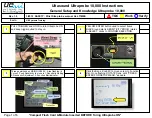
36
Is this system compatible with methanol or ethanol?
This system is compatible with methanol and ethanol fuels. While this system
will accurately measure air/fuel ratio information with these fuels, most
engine management systems will only display gasoline air/fuel ratios.
Why do I keep seeing 1 Stored Run with 0 Data Samples in the Data Logger?
When your Data Logger is configured to record Data from a Generation 7+
ECM, the serial communications cable must be properly connected to the
CalMap Data Cable from the ECM
through the supplied adapter
in order for
data to be recorded properly. If the Data Logger is activated without the
proper serial data connection to the ECM, the Data Logger will increment the
number of runs stored in memory, but will be unable to store any data
samples due to the improper or missing serial data connection.
Make sure the Engine Analyzer’s serial data cable is connected to the CalMap
Communications cable using the adapter provided with your Engine Analyzer
kit. The connection must be made with that or an electrically similar adapter
in order for the devices to properly communicate with each other.
What contaminants can damage the oxygen sensor?
One of the most common causes of oxygen sensor failure is contamination
from engine oil in the exhaust. This is usually the result of excessive
amounts of crankcase blow-by or leaking turbocharger oil seals. Excessive
carbon buildup from rich fuel mixtures is another common cause of premature
oxygen sensor failure. Engine coolant in the exhaust system can also damage
oxygen sensors, particularly if there is antifreeze in the cooling system.
Uncured silicone vapors can damage oxygen sensors. If you use silicone to
seal your exhaust system, the silicone should be allowed to cure overnight
before installing the sensor in the exhaust.
This system reads much richer/leaner than another wideband controller
that I use. Which one is correct?
Accel DFI wideband control systems are measured against state-of-the-art
laboratory control systems and are accurate to within .1 AFR across the entire
operating range. Also, every system that is shipped from Accel DFI is tested
and calibrated on a sophisticated testing machine. The tester calibration, in
turn has been validated on an actual running engine under multiple running
conditions to ensure accuracy and functionality. In addition, this test
equipment is also verified against specialized test gas samples. While most
systems offer accuracy at near-stoichiometric air/fuel ratios, the Accel DFI
system provides unparalleled accuracy at the much richer air/fuel ratios
needed at high power levels.
In turbocharged applications, where should the oxygen sensor be located?
The oxygen sensor should be mounted in the downpipe, not in the collector.
The sensor should be at least 8 inches from the turbocharger. The extreme
heat and exhaust system backpressure found in the collector(s) of a



































